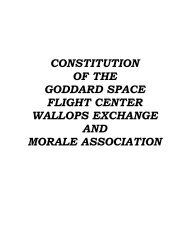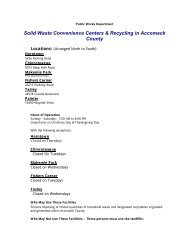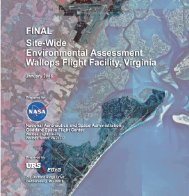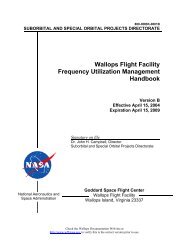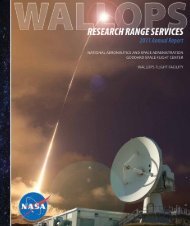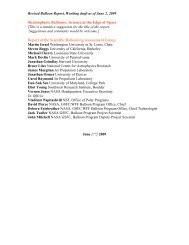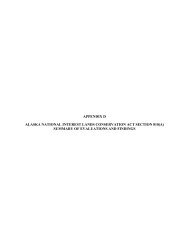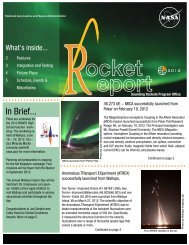Phil Eberspeaker - Wallops Flight Facility - NASA
Phil Eberspeaker - Wallops Flight Facility - NASA
Phil Eberspeaker - Wallops Flight Facility - NASA
Create successful ePaper yourself
Turn your PDF publications into a flip-book with our unique Google optimized e-Paper software.
<strong>NASA</strong> Strategic Plan Sub-goal 3B:<br />
Understanding the Sun and its effect on<br />
Earth and the solar system.<br />
<strong>NASA</strong>’s Strategic Plan Sub-goal 3C:<br />
Advance scientific knowledge of the origin<br />
and history of the solar system, the potential<br />
for life elsewhere, and the hazards and<br />
resources present as humans explore space.<br />
<strong>NASA</strong>’s Strategic Plan Sub-goal 3D:<br />
Discover the origin, structure, evolution<br />
and destiny of the universe, and search for<br />
Earth like planets.<br />
<strong>NASA</strong>’s Strategic Plan Sub-goal 3E:<br />
Advance knowledge in the fundamental<br />
disciplines of aeronautics, and develop<br />
technologies for safer aircraft and higher<br />
capacity airspace.<br />
Sub-SEM ready to launch,<br />
June 2006<br />
8 Sounding Rockets Annual Report 2007<br />
Sounding Rockets Support <strong>NASA</strong>’s<br />
Strategic Goals<br />
Heliophysics and Earth Sciences<br />
Heliophysics support includes launches to study the fundamental<br />
processes connecting the Sun and Earth. The solar corona is studied with<br />
Extreme UV and X-ray telescope payloads. In-situ measurements of the<br />
ionosphere are conducted with Sounding Rocket instruments flown from<br />
launch sites around the world. Arctic launch sites support the study of<br />
Noctilucent clouds and Polar Mesospheric Summer Echos (PMSE), as well<br />
as studies associated with the Aurora Borealis.<br />
Astrophysics<br />
In the high energy and the ultraviolet and visible part of the spectrum,<br />
Astrophysics utilizes sounding rockets for testing of new instruments and<br />
for unique observational science missions.<br />
Aeronautics<br />
Sounding rockets contribute to <strong>NASA</strong>’s aeronautics program by providing<br />
high-speed test beds for fundamental aeronautical research.<br />
Sounding rockets provide a realistic hypersonic flight test environment for<br />
new materials, shapes and aeronautical concepts.<br />
Planetary Sciences<br />
Studies of planetary and cometary atmospheres have been conducted<br />
with sounding rockets.<br />
Sub-SEM launch,<br />
June 2005<br />
Terrier-ASAS motor test<br />
round, June 2005<br />
Black Brant XI launch,<br />
September 2006



